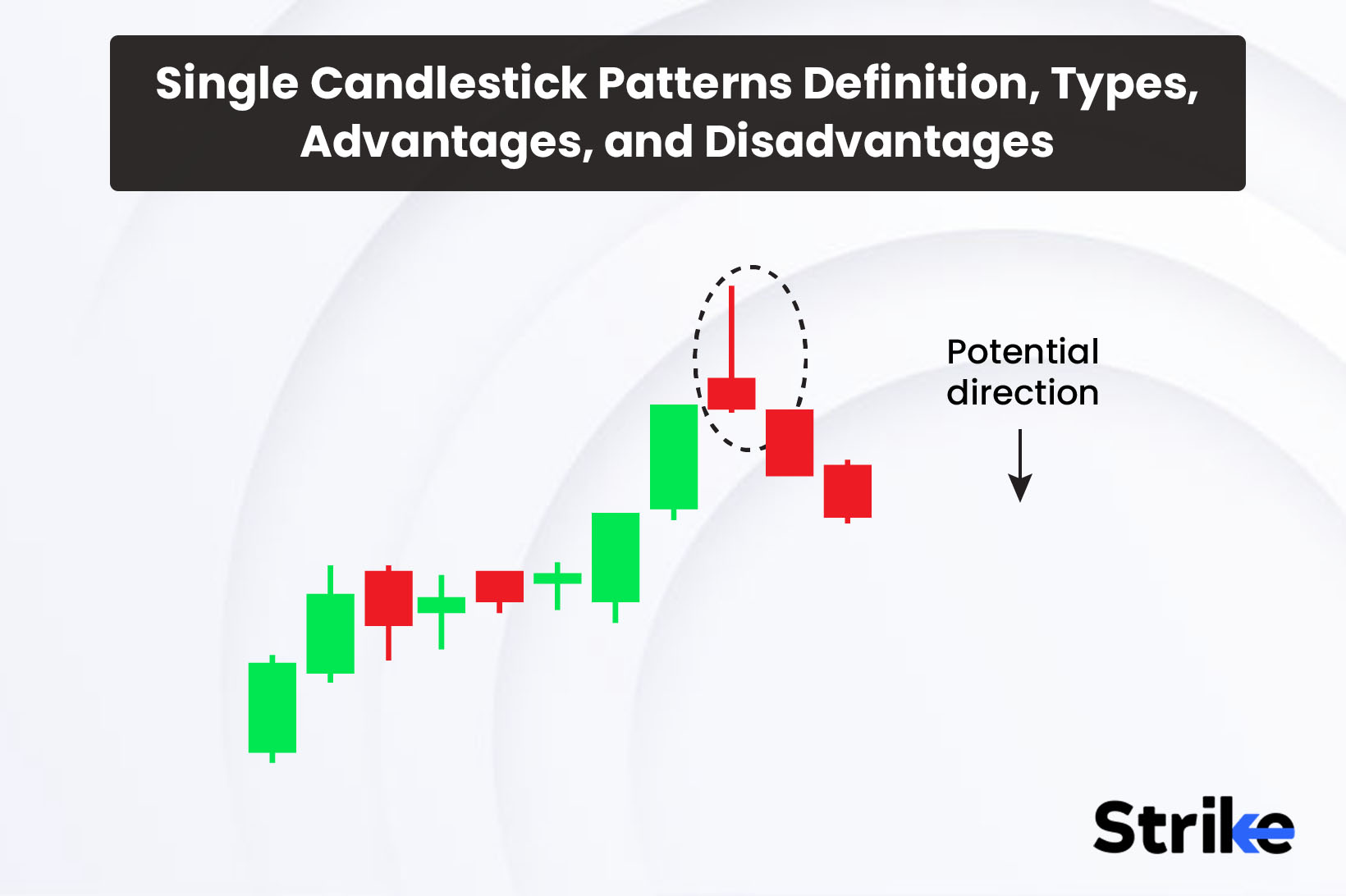
Single candlestick patterns are individual candlestick formations that provide trading signals within a single candle. They differ from multi-candlestick patterns like the head and shoulders, which require two or more candles to form. These single-candle patterns can identify potential reversals or continuations of the current trend.
The most commonly used single candlestick patterns are the hammer, inverted hammer, shooting star, and hanging man. They have specific shapes that signal potential bullish or bearish reversals when they occur at market bottoms or tops, respectively. Their formation reflects a tug-of-war between buyers and sellers during the period of the candle.
The hammer and inverted hammer have small, real bodies with long lower wicks reflecting strong buying pressure. The buying momentum pushes the price up after hitting lows, creating the long lower wick. They signal potential upside reversals when found at market bottoms.
On the other hand, the shooting star and hanging man have small, real bodies but long upper wicks. The long wicks reflect selling pressure that pushed the price down from highs, which could lead to bearish reversals at market tops.
Besides forecasting trend reversals, single candle patterns like pin bars and doji can also suggest potential trend continuations. A pin bar shows rejection of a key support or resistance level with its long tail. The doji’s indecision indicates consolidation before eventual breakouts.
The advantage of single-candle patterns is they provide quick trading signals within just one candle period. Their simple shapes make it easy to identify potential entry points. Single candle patterns can be useful for short-term day trading strategies due to their speed.
However, their disadvantage is the higher false signal risk compared to multi-candle patterns. A single candle provides a limited price action context, unlike broader formations. Using other indicators like volume to confirm the candle signal improves reliability.
What are Single Candlestick Patterns?
Single candlestick patterns are individual candlesticks that provide trading signals and insights into market psychology over a single period. Candlestick charts display the open, high, low, and closed prices for security over a set timeframe. The color and shape of the candlestick indicate the relationship between the open and closed as well as the high and low. Single candlesticks provide valuable information about the battle between market bulls and bears during that time frame.
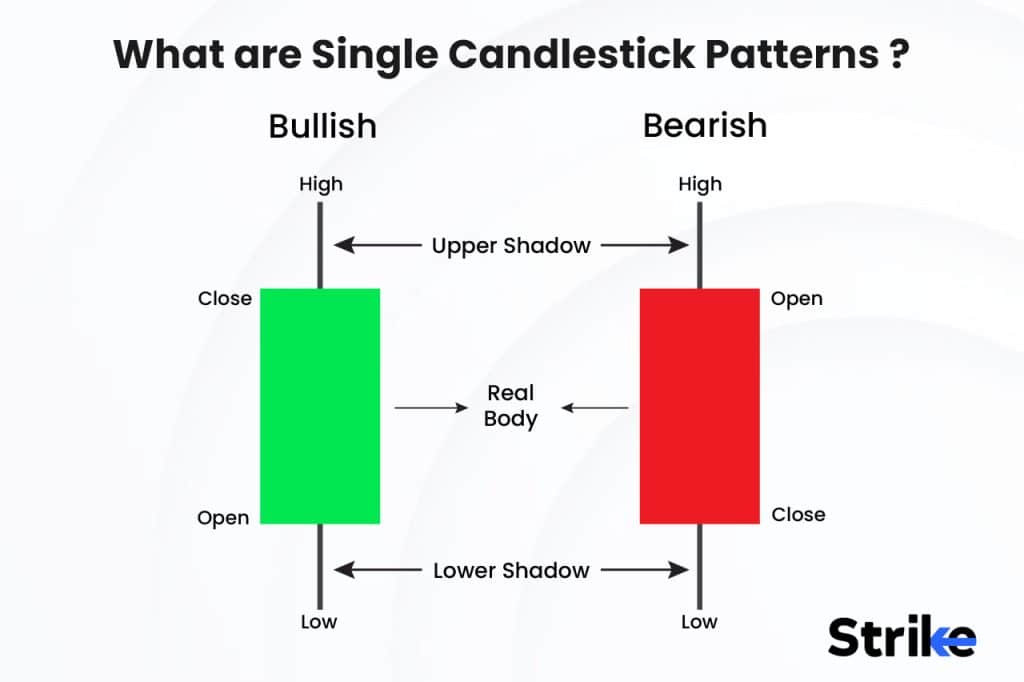
Understanding single candlestick patterns is important for technical analysts and traders looking to identify shifts in momentum and sentiment. Major single candlestick signals aid in spotting potential trend reversals, continuations, indecision, and volatility. The most common and reliable single candlestick patterns include the long candle, short candle, marubozu, spinning top, and doji.
The long candle or bullish candle shows strong buying pressure during that period. It has a large real body at the upper end, showing the bulls were in control. The open is near the low, and the close is near the high after rallying significantly. Long green candles show strong upside momentum in an uptrend. Long red candles show bullish exhaustion after an advance and potential weakness.
The short candle or bearish candle reveals intense selling pressure. It has a small real body at the lower end, indicating the bears overwhelmed buyers. The open is close to the high, while the close is near the low after a sharp decline. Short green candles signal waning downside momentum after a selloff. Short red candles confirm strong downside momentum in a downtrend.
Marubozu candlesticks have no wicks or shadows, and the entire body engulfs the period from open to close. A green or white marubozu shows extremely strong buying pressure as prices rallied the whole session. Red or black marubozu candles indicate unrelenting selling pressure as prices fall steadily lower. Marubozu signals a commitment to the prevailing trend direction and continuation.
Spinning tops form when the candle has small bodies with upper and lower shadows that exceed body length. The narrow range reflects market indecision and uncertainty. Bulls and bears battle, but neither gains an edge, resulting in an unchanged close or small real body. Spinning tops warn of potential reversals after uptrends or downtrends.
Doji candlesticks look like a cross as the opening and closing are equal. The session opens and rallies but sells off to close at or near the open price. Dojis indicates that balancing between supply and demand leads to a stalemate. Their neutrality highlights market indecision or consolidation. Dojis, after sustained trends, provide reversal signals for trend traders.
Single candlestick patterns help traders understand price action and market psychology. The following are some of their important signals.
Learning to recognize and interpret single candlestick patterns along with multi-candlestick combinations allows traders to better time entries and exits. Candlestick signals should be confirmed through other forms of technical analysis for robust trading opportunities. Single candlesticks are powerful tools for visualizing shifts in supply and demand over a trading session.
What Does a Single Candlestick Pattern Indicate?
Single candlestick patterns each indicate unique insights into the psychology between bullish and bearish forces over a specific trading session. The shape, color, and components of an individual candlestick reflect the battle between buyers and sellers during that period. Analyzing a candlestick’s structure and where it emerges in the context of previous price action offers clues about current sentiment and future direction.
Single candlesticks indicate whether bulls or bears are in control and the strength of their conviction. Longer real bodies signify intense momentum from either buyers or sellers. Small, real bodies represent indecision and consolidation. Upper and lower wicks show where the battle lines were drawn and how prices fluctuated between support and resistance.
The color of the real body conveys critical information. Green or white candles indicate the close finished higher than the open as buying triumphed. Red or black candles show the close was lower than the open as bearish forces prevailed. The relationship between the open, close, and wicks reveals singular insights during that trading period.
Long green or white candles demonstrate strong buying pressure and upside momentum. The buying was sustained from open to close, while bears were only able to briefly push prices down, as seen by the small lower wick. Long candles in an uptrend confirm the continuation of the bull move. In a downtrend, long white candles sometimes mark bullish reversals of the existing bearishness.
Long red or black candles signal intense selling pressure where bears forcefully pushed prices lower throughout most of the session. Sellers maintained control, while bulls were only able to stage a minor rally, as seen in the small upper wick. Long red candles show strong downside momentum in a downtrend. In uptrends, long black candles sometimes flag a potential bearish reversal.
Short candles indicate a period of consolidation and indecision between buyers and sellers. The small real body shows neither side could sustain control, and the session closed largely unchanged from the open. Short green candles usually emerge in downtrends as bulls start gaining ground and resistance mounts. Short red candles generally arise in uptrends as bears begin to overwhelm buyers and support weakens.
Marubozu candles with no wicks show full control by buyers or sellers from open to close. Green or white marubozus indicator buyers remained in command the entire session and pushed the price steadily higher into the close. Red or black marubozus demonstrate sellers maintained pressure throughout and drove prices lower into the close. Marubozus reinforces the strength of the ongoing trend.
Spinning tops form when the candle has tiny real bodies and long upper/lower wicks. The wicks show prices fluctuated widely between support and resistance, while the small body reveals the close was little changed from the open. Spinning tops reflect a closely fought battle between bulls and bears, resulting in stalemate and indecision. They signal potential exhaustion and trend reversals.
Doji candles look like a cross as the opening and closing are equal, and there is almost no real body. Dojis indicate complete indecision as neither buyers nor sellers could gain control. The equals open and close demonstrates a balance between supply and demand. After solid trends, doji candles become significant reversal signals.
Traders should interpret single candlesticks in conjunction with other technical analysis tools such as trend lines, support/resistance levels, momentum oscillators, and volume. Confirmation from these techniques gives a higher probability that the candlestick signal will play out. For instance, a long white candle-breaking resistance substantiates an upside breakout.
Analyzing the implications of single candlesticks in the proper context improves the chances of accurately forecasting future price direction. Their messages should be confirmed through multi-timeframe analysis, indicators, and complementary candlestick patterns. Single candlesticks provide powerful visual snapshots of the trading session and are invaluable to timing profitable trades.
What Are the Different Single Candlestick Patterns?
There are many types of single candlestick patterns that provide trading insights and signals. The following are ten significant single candlestick patterns.
1. Shooting Star Candlestick Pattern
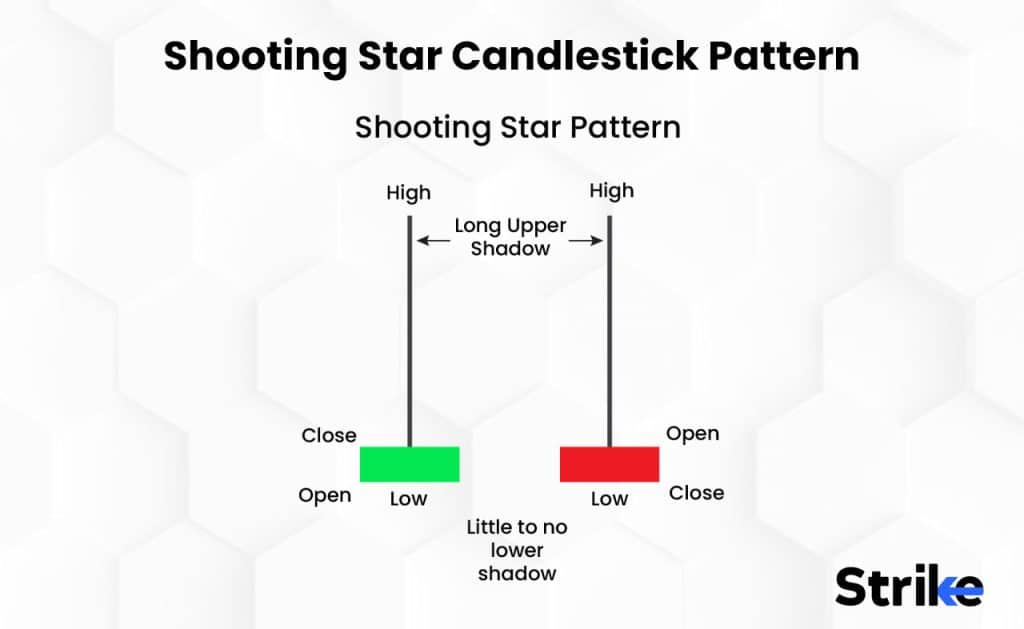
The shooting star is a single-candlestick pattern that indicates potential trend reversals and exhaustion. The following components make it up.
Body: The body is small and located near the bottom of the candlestick’s range. The color is not important, although a black or red body indicates more bearishness.
Wick: A long upper wick extends well above the body, showing prices traded much higher but closed near the bottom. This reveals selling pressure.
Location: The shooting star appears in an uptrend and signals potential topping behavior and weakness ahead.
Recognition: The small body shows indecision, while the long wick reflects rejection from higher prices. The close near the lows generates a shooting star shape.
Meaning: The shooting star shows upside momentum is waning. Demand weakened as sellers drove prices back down from the high. Bearish momentum is building in the uptrend.
Pros
Clear pattern that is easy to identify visually on the chart.
Gives a warning of potential trend reversal ahead.
Indicates optimal area for bearish positions if confirmed.
Cons
As a single candle, additional confirmation was needed.
Does not automatically trigger a bullish reversal by itself.
In isolation, sometimes, it won’t capture true shifts in sentiment.
To trade a shooting star signal, confirmation through indicators or other candlesticks is required. The candlestick gains significance if it emerges after a strong advance, around resistance, or on increasing volume. Bearish indicators like MACD crossover or RSI divergence add credence.
Further negative candles like long red bodies, doji spins, or engulfing patterns would confirm the reversal. Placing bearish trades with a shooting star signal still demands sound risk management. Stop orders above the candlestick high to protect against premature entries. Shooting stars give early warnings of trend shifts that require follow-through to capture.
2. Hanging Man Candlestick Pattern
The hanging man is a single-candlestick pattern that emerges at market tops and warns of potential trend reversals. It is made up of the following elements.
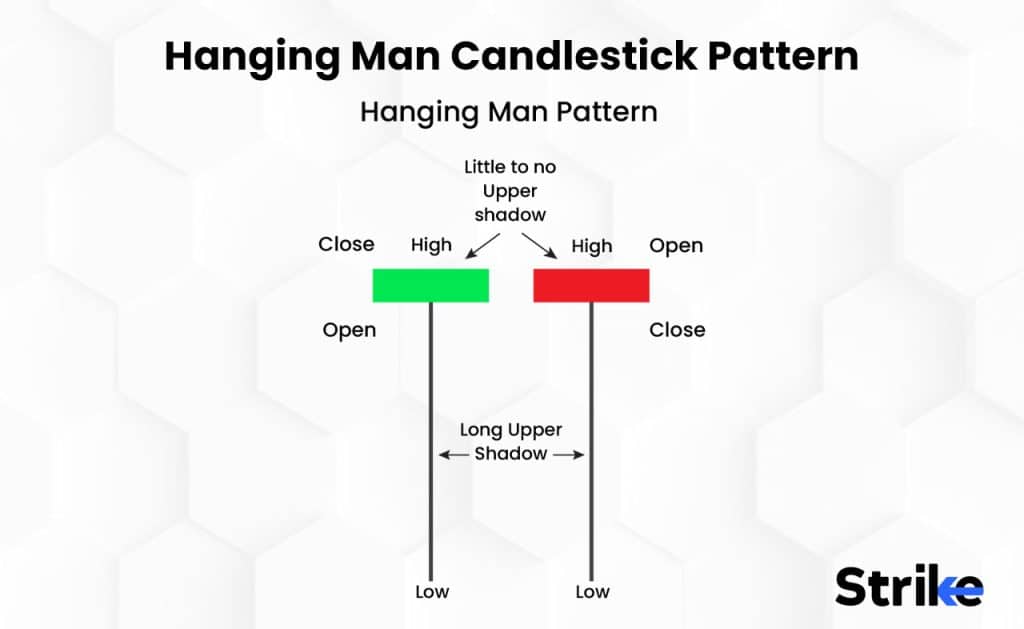
Body: The body is small and located near the top of the candlestick’s range. Color is not critical, but a black or red body shows more bearishness.
Wick: A long lower wick extends down below the body, indicating prices traded much lower intraday before closing back up. This reveals buying pressure.
Locatio: The hanging man appears in an uptrend and signals a potential turn lower ahead as upside momentum fades.
Recognition: The small body and long lower wick give the candlestick a hanging man shape. This shows indecision and rejection of lower prices.
Meaning: The pattern indicates buying interest emerged despite the uptrend. Bears were able to briefly push prices down before buyers resurfaced. Upside conviction is waning in the trend.
Pros
Visually easy to identify the shape on the chart.
Warns early of potential trend exhaustion and reversal.
Pinpoints area to watch for bearish trades if confirmed.
Cons
Requires additional confirmation as a single candlestick.
Does not automatically trigger a bullish reversal alone.
In isolation, sometimes, it won’t capture true shifts in sentiment.
To trade a hanging man signal, traders wait for confirmation through indicators or additional candlesticks. The pattern gains significance with bearish divergence on momentum oscillators, increasing volume, or resistance tests. Follow-through red candles, doji spins, and engulfing patterns add confidence.
Bearish positions are warranted only with proper confirmation and risk management. Initial stops above the candlestick’s high limit premature entries. Hanging men flag impending trend shifts that need follow-through selling for profitable trades.
3. Inverted Hammer Candlestick Pattern
The inverted hammer is a single-candlestick formation that indicates potential bottoming behavior and trend reversals. It is composed of the subsequent elements.
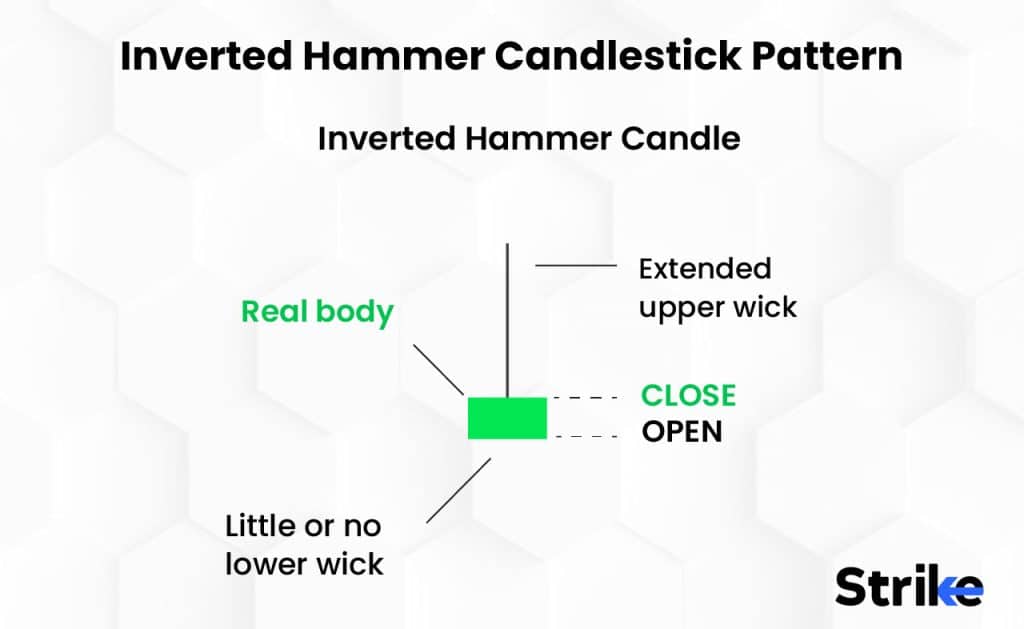
Body: The body is small and located near the top of the candlestick’s range. Its color is unimportant, although a white or green body reflects more bullishness.
Wick: A long upper wick extends well above the body, showing prices rose but closed near the lows. This reveals selling pressure.
Location: The inverted hammer appears in a downtrend and signals possible capitulation as selling pressure wanes.
Recognition: The pattern’s small body and long upper wick give it an inverted hammer shape. This shows indecision and rejection of higher prices.
Meaning: The candle reflects bearish control is diminishing, and upside momentum is building. The buying pressure suggests the potential for a bullish trend reversal.
Pros
Visually easy to recognize the inverted hammer shape.
Provides early warning of market bottom and trend reversal ahead.
Pinpoints area to anticipate bullish trades if confirmed.
Cons
Requires additional confirmation as a single candlestick.
Does not automatically guarantee a bullish reversal alone.
In isolation, sometimes, it won’t capture true shifts in market sentiment.
Traders wait for confirmation of an inverted hammer signal through indicators or additional candlesticks before acting. Significance increases with bullish divergence on oscillators, increasing volume, or support tests. Follow-on white candles, doji patterns, and engulfing formations add confidence.
Initiating bullish trades warrants caution until proper confirmation. Stops below the candlestick’s low limit premature long entries. Inverted hammers flag possible trend shifts that require follow-through buying for successful trades.
4. Doji Candle Pattern
The doji is a single-candlestick pattern signifying indecision and consolidation. It is made up of the following elements.
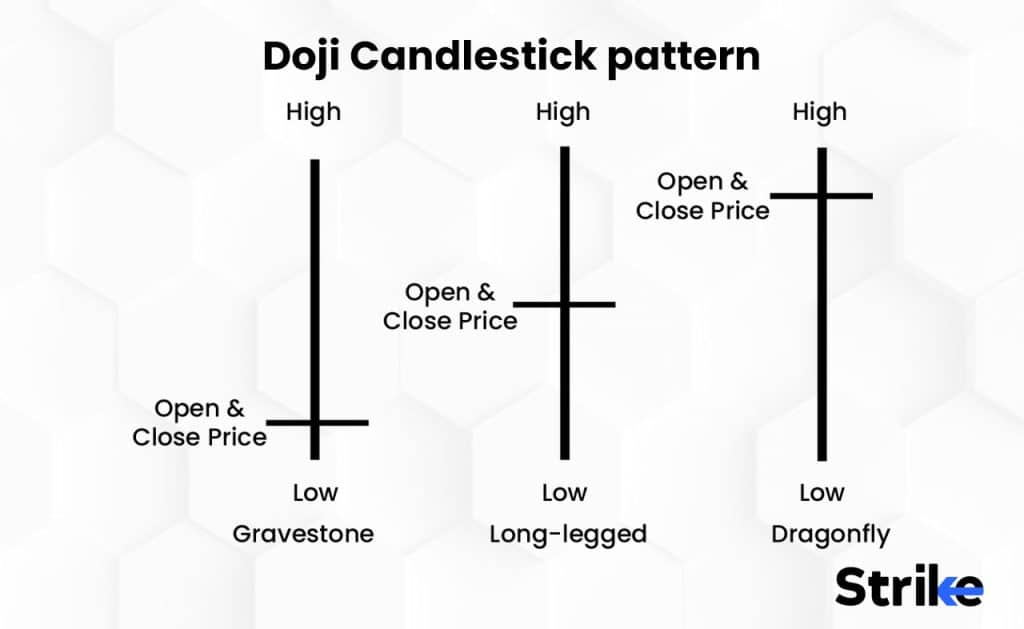
Body: The body is extremely small or non-existent, appearing as a cross line on the chart. The opening and closing are virtually equal.
Wicks: Upper and lower wicks vary from small to quite long, depending on the trading range.
Location: Dojis emerge after sustained trends, highlighting potential exhaustion and reversals ahead.
Recognition: The lack of a real body and equal opening/closing gives the doji its cross-like shape. This reflects the equilibrium between buyers and sellers.
Meaning: The candle shows neither bulls nor bears could gain control and close the session decisively. The stalemate indicates a possible trend reversal.
Pros
Very visually distinct candlestick that is easy to identify.
Signals potential trend exhaustion and reversal points.
Pinpoint areas to anticipate trend shifts if confirmed.
Cons
Requires additional confirmation as a single candlestick.
Does not automatically guarantee a trend reversal itself.
In isolation, sometimes, it does not truly represent shifting sentiment.
Traders wait for confirmation of a Doji signal through indicators or additional candlesticks before acting. Significance increases at key support/resistance levels, with divergence, and on higher volume. Follow-on long candles, engulfing patterns, and moving average crosses add confidence.
Entering counter-trend trades warrants caution until proper confirmation. Stops above/below the doji’s range limit premature entries. Dojis flag possible trend shifts that need follow-through confirmation for high-probability setups.
5. Spinning Top Candlestick Pattern
The spinning top is a single candlestick formation indicating uncertainty, consolidation, and potential trend reversals. It is made up of the following components.
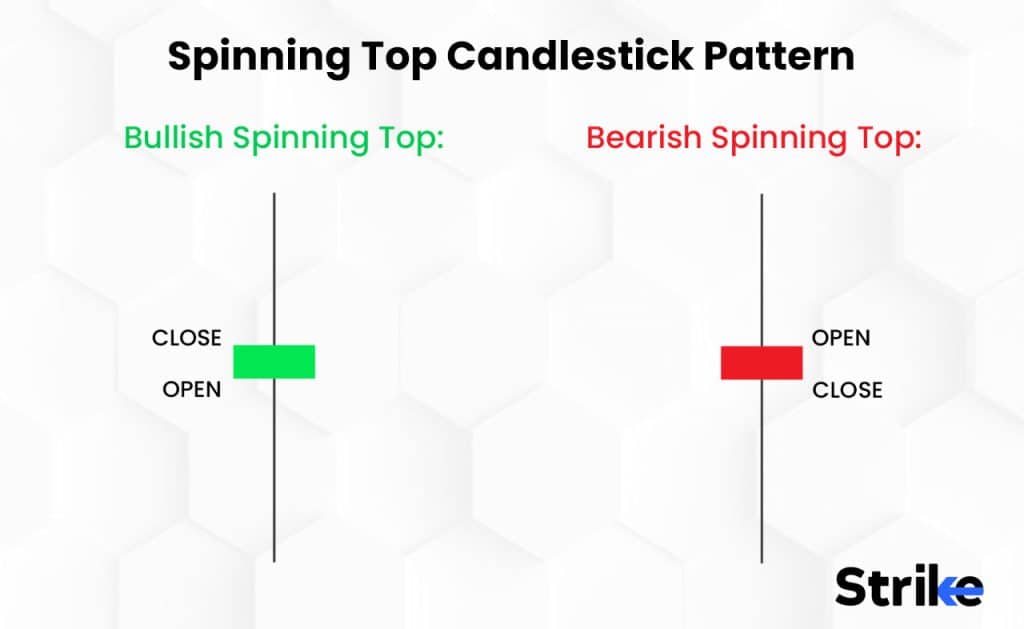
Body: The body is small, showing a narrow range between the open and closed prices. Colour is mixed and not critical.
Wicks: Upper and lower wicks are large relative to the real body. This reflects volatility between support and resistance.
Location: Spinning tops emerge after uptrends or downtrends, signaling indecision and possible exhaustion.
Recognition: The small real body and large wicks give the candlestick a spinning top shape. This reflects a tight battle between bulls and bears.
Meaning: The mixed trading activity shows neither buyers nor sellers could gain control. The stalemate indicates diminishing momentum and a potential change in trend direction.
Pros
The distinct candlestick shape makes it easy to identify.
Warns early of potential trend exhaustion and reversals.
Signal areas to watch for trend shift trades if confirmed.
Cons
Requires additional confirmation as a single candlestick.
Does not definitively guarantee a trend reversal itself.
In isolation, it sometimes won’t capture true market psychology.
Traders wait for confirmation of a spinning top’s signal through indicators or additional candlesticks. Significance increases at support/resistance levels, with divergence and expanding volume. Follow-on long candles, engulfing patterns, and trendline breaks add confidence.
Entering counter-trend trades still requires caution until proper confirmation. Stops above/below the spinning top’s range limit premature entries. Spinning tops flag potential trend shifts needing follow-through for high-probability setups.
6. Bullish Harami Candlestick Pattern
The bullish harami is a two-candle reversal pattern signaling a potential bottom and uptrend ahead. The following components make it up.
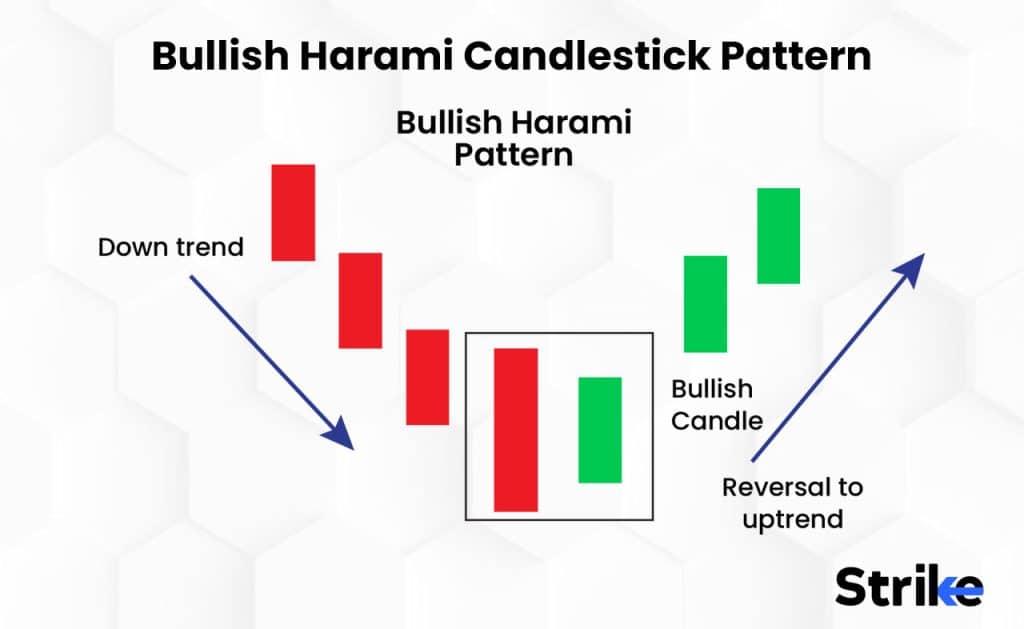
First Candle: A long red or black candle that continues the existing downtrend. This shows bearish control.
Second Candle: A smaller green or white candle contained within the first candle’s body. This reveals bullish pressure emerging.
Recognition: The large engulfing candle followed by the small real body candle gives the pattern a pregnant appearance. This signals a potential trend reversal.
Location: The formation of the harami following a decline indicates that negative momentum is possibly diminishing as buyers reappear.
Meaning: The first candle shows sustained selling pressure. However, the second candle reflects growing strength among buyers to reverse the decline. Upside momentum is building.
Pros
Distinct two-candle pattern that is easy to spot.
Signals bottoming behavior and potential bullish reversal ahead.
Defines risk/reward levels for trades if confirmed.
Cons
Needs confirmation from other indicators and patterns.
Does not guarantee a bullish reversal by itself.
A small sample size limits robustness.
Traders wait for confirmation of the reversal signal through volume, candlestick follow-through, and momentum oscillators. Bullish divergence, ascending trend lines, and moving average crosses add confidence. Caution is warranted until confirmation, as haramis can be false reversals. Stops under the pattern limit risk. The harami flags a potential upside that needs confirmation for high-probability trades.
7. Doji Star Candle Pattern
The doji star is a three-candle reversal pattern signaling potential trend exhaustion. It is made up of the following components.
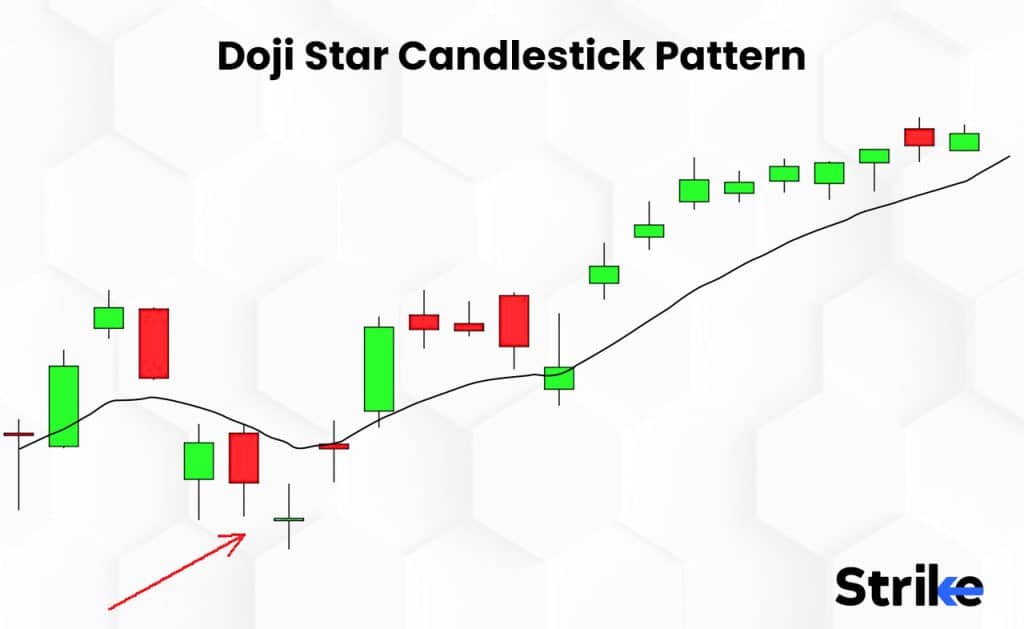
First Candle: A long-bodied candle continuing the current trend direction. This reflects momentum.
Doji: A doji candle following the first candle signifies indecision after the trend. Its cross-like appearance shows equilibrium between buyers and sellers.
Third Candle: A candle moving opposite the prevailing trend, confirming a potential reversal.
Recognition: The pattern sequence of a long candle, doji, and opposite-colored candle forms a doji star shape. This suggests that a trend change is possible.
Location: The doji star emerges after an established uptrend or downtrend, flagging waning momentum.
Meaning: The long candle shows the trend extending. The doji reflects uncertainty entering the market. The third candle confirms the doji’s reversal signal that supply/demand has shifted.
Pros
Unique pattern that clearly signals trend reversals.
Doji makes the exhaustion point visually distinct.
Defines potential entry, stop, and target levels.
Cons
Needs supporting indicators and patterns for confirmation.
A small sample size limits the robustness of the signal.
Individual components generate false signals.
The doji star requires confirmation from volume, indicators, and candlestick follow-through. Bullish/bearish divergence, moving average crosses, and continuation patterns all increase the validity of the reversal. Caution is essential until confirmation as stars whipsaw. Stops above/below the doji’s range define risk parameters. The doji star flags trend exhaustion that needs verification before acting.
8. Marubozu Candle Pattern
The marubozu is a single candlestick pattern indicating strong momentum and trend continuation. The elements that make up it are as follows.
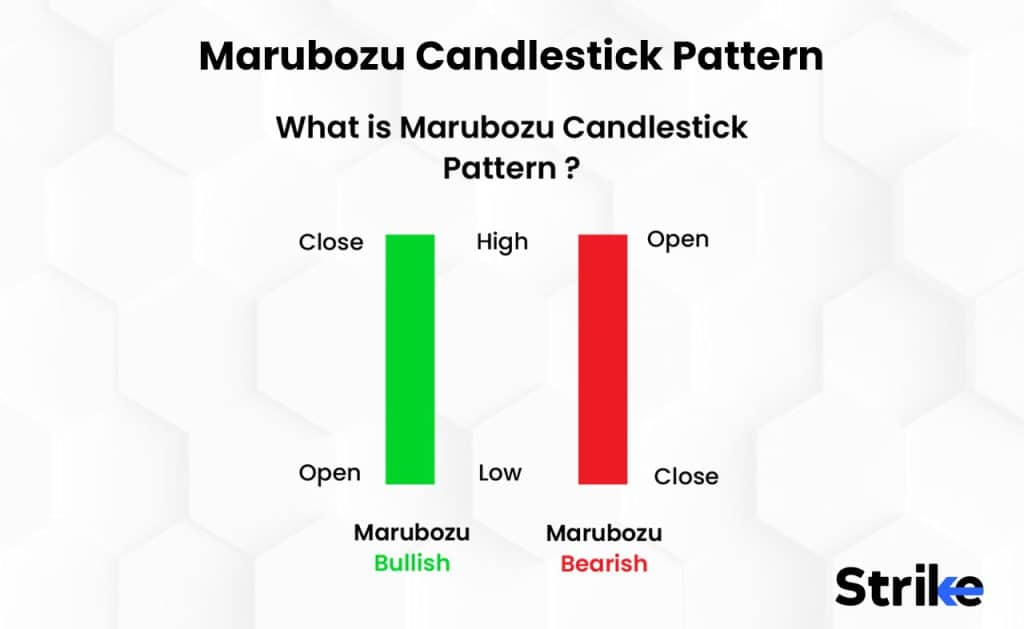
Body: The body is large and engulfs most of the candlesticks, ranging from open to closed. A white or green body shows bullish control. A black or red body reflects bearish control.
Wicks: There are little to no wicks as prices drove steadily in one direction throughout the session.
Location: Marubozus emerges in the direction of the prevailing uptrend or downtrend, signaling continuation.
Recognition: The dominant long body and lack of wicks give the marubozu a bold, shaven appearance. This shows the full control of buyers or sellers.
Meaning: The candle reflects intense pressure from bulls or bears without opposition. Their conviction suggests the trend will prolong versus reverse.
Pros
Easy to identify based on the long body and missing wicks.
Indicates strong momentum and trend continuation.
Signals optimal areas to trade in the trend’s direction.
Cons
Additional confirmation is preferable as a single candlestick.
Does not automatically guarantee the trend will extend.
Isolation limits insights into shifts in market psychology.
The marubozu’s robust trend signal is strengthened with confirmation from the volume, indicators, and continuation patterns. Bullish/bearish convergence, moving average slopes, and higher highs/lower lows add confidence. Traders still exercise caution as overextended moves reverse. Stops below bullish or above bearish marubozus define risk parameters.
9. Evening Star Forex Pattern
The evening star is a three-candle reversal pattern signaling a potential market top and downtrend ahead. The following are the elements that comprise it.
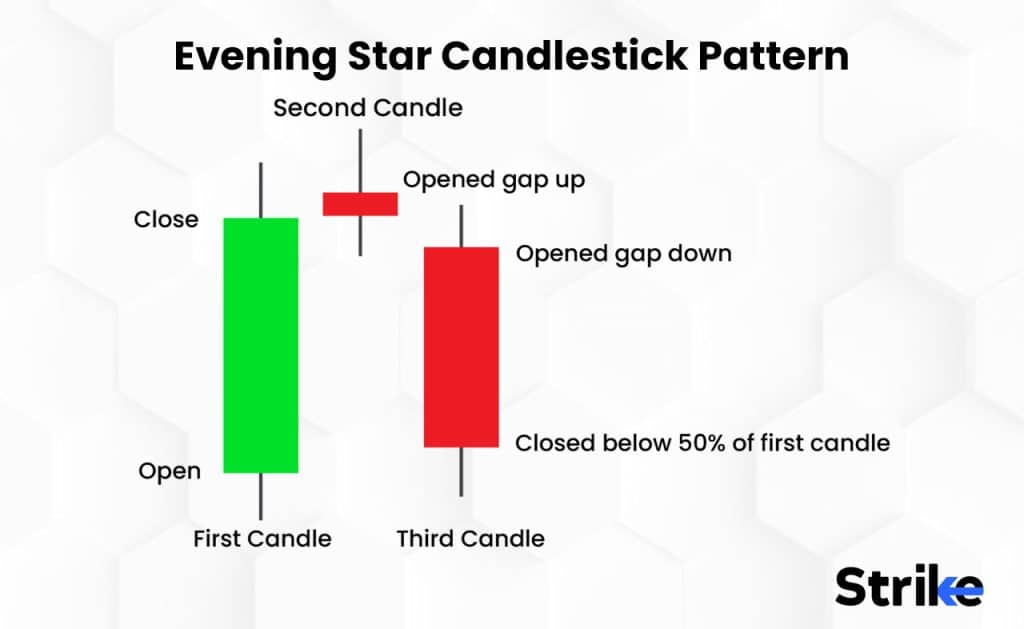
First Candle: A long bullish white or green candle continuing the uptrend. This shows buying pressure.
Second Candle: A small-bodied candle in the middle of the pattern that has higher gaps. This reveals indecision.
Third Candle: A long, bearish red or black candle closing below the midpoint of the first candle. This confirms weakness.
Recognition: The tall white candle, followed by the small gapped candle and then the long red candle, forms an evening star shape, indicating a potential trend reversal.
Location: The pattern emerges after an uptrend as a warning of exhaustion in upside momentum.
Meaning: The buying pressure of the first candle fades with the indecision of the middle candle. Sellers take control in the third candle, reflecting shifting market psychology.
Pros
Unique pattern that clearly signals trend reversals.
Pinpoints reversal zone for optimal entry and stop levels.
Visually easy to identify the shape on the chart.
Cons
Requires supporting technicals and patterns for confirmation.
A small sample size limits the robustness of the signal.
Components generate false signals in isolation.
Confirmation is needed from volume, indicators, and candlestick follow-through to verify the pattern’s reversal signal. Bearish divergence, descending trend lines, and continuation candlesticks add confidence. Caution is essential until confirmation, as stars sometimes whipsaw. Stops above the middle candle define risk parameters. The evening star flags trend exhaustion requiring follow-through before acting.
10. Long-Legged Doji Candlestick Pattern
The long-legged doji is a single candlestick pattern signifying uncertainty and consolidation. It is made up of the components listed below.
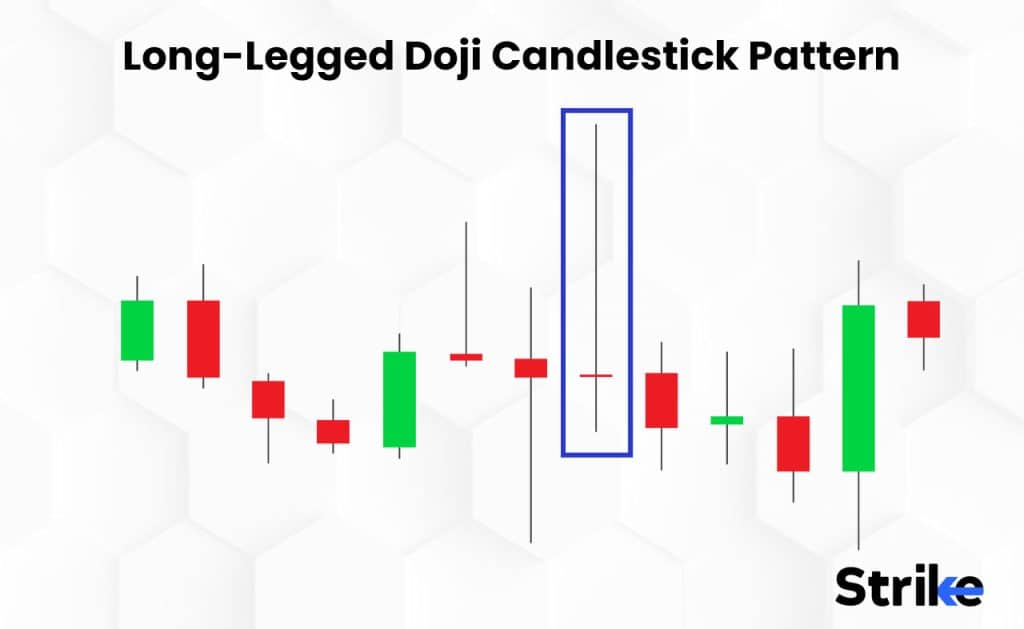
Body: The body is extremely small or non-existent, appearing as a cross on the chart. The opening and closing are virtually equal.
Wicks: The upper and lower wicks are very long, showing a wide trading range during the period.
Location: Long-legged dojis emerge after an established trend, highlighting potential exhaustion and reversals.
Recognition: The lack of a body and very long wicks stretching out above and below give it a long-legged doji shape. This reflects indecision.
Meaning: The wide price swings show both bullish and bearish forces were active but ultimately closed unchanged, indicating a possible trend reversal ahead.
Pros
Distinct candlestick that is easy to spot visually.
Signals of an upcoming shift in sentiment and trend direction.
Pinpoints key levels for entries and stops if confirmed.
Cons
Additional confirmation is required as a single candlestick.
Does not definitively guarantee a trend reversal itself.
In isolation, sometimes, it won’t capture true market psychology.
Traders wait for confirming indicators and candlesticks before acting on long-legged doji signals. Momentum divergence, increasing volume, and continuation patterns all add confidence. Caution is essential until confirmation, as Dojis sometimes whipsaws. Stops outside the doji’s range limit risk on counter-trend trades. Long-legged dojis flag potential trend shifts needing verification.
Of these single candlestick patterns, the doji and marubozu are considered the most powerful signals. Doji candles represent critical indecision after sustained trends, highlighting potential exhaustion and reversals. Marubozu candles demonstrate intense conviction from buyers and sellers throughout the entire period. Analyzing candlesticks in the proper context is crucial to effectively trade their signals.
How do you read the Single Candlestick Pattern in Technical Analysis?
Evaluating individual candlesticks is a core skill in candlestick charting and technical analysis. Traders gain powerful insights into market psychology and future price direction when they are armed with the ability to decipher single candlestick signals. While interpreting single candlestick formations, remember the following advice.
First, identify the color of the real body. The color indicates whether the close was higher or lower than the open. Green or white candles show the close finish above the open as bulls were in control. Red or black candles indicate the close was lower than the open as selling pressure dominated. The color establishes if buyers or sellers commanded the trading session.
Next, note the size of the real body relative to the candle’s range. Longer real bodies illustrate intense momentum in one direction or the other. The longer the body, the more conviction behind the bulls or bears. Small real bodies demonstrate indecision and consolidation as neither side gained sustained control. Real body size reflects the intensity of the battle between supply and demand forces.
Observe the position of the real body within the trading range. Real bodies at the top of the candle’s range reveal bullish dominance, while real bodies at the bottom reflect bearish control. The location of the real body shows which side was in command. For example, long lower wicks underline buying pressure, and long upper wicks reflect selling pressure during the session.
Analyze the candlestick’s wicks relative to its real body. Large wicks demonstrate prices reversed intraday before closing near the open. Small or no wicks indicate control by buyers or sellers throughout the period as prices steadily trended. Wicks illustrates how the tug-of-war between bulls and bears played out during the session.
Consider volume when evaluating the candlestick’s conviction. Increased volume adds potency to the candle’s message. Heavy volume on bullish or bearish candles shows the power behind the move. Low volume indicates limited conviction. The volume provides clues regarding the health of the candle’s signal.
Importantly, interpret the candlestick’s meaning based on the prevailing market trend. Long green candles indicate bullish continuation in uptrends but potential bullish reversals in downtrends. Short red candles signal a bearish continuation in downtrends but potential topping behavior in uptrends. Context and location impact the candle’s significance.
Finally, move through different time frames when analyzing candlesticks. Look at 1 minute, 5 minute, hourly, 4 hour, and daily charts. Assess how the candlestick conforms to support/resistance levels and whether indicators confirm or diverge. Multi-timeframe analysis enhances candlestick robustness.
No single candlestick should be viewed in isolation when performing technical analysis. In technical analysis, it’s essential to look for clusters of confirming signals from adjacent candles, trends, momentum oscillators, and trading volume. A candlestick loses significance if emerging candlesticks, indicators, and chart patterns conflict with its message. This approach ensures a more comprehensive understanding of market trends and potential movements.
How do you trade in the stock market using a single candlestick pattern?
Single candlestick patterns provide effective trade signals when incorporated properly within a robust trading plan. Follow the following guidelines to trade candlestick indications in stocks.
First, stick to high-volume stocks and ETFs when trading candlestick patterns. Liquid markets ensure minimal slippage on entries and exits. Use scans to identify stocks exhibiting strong price action and daily volumes above the 50-day average.
Next, master pattern recognition of key single candle reversals like dojis, hammer, shooting star, and engulfing candles. Read books, review charts, and take notes. Candlestick mastery comes through repetition.
Set risk management rules before trading any candlestick signal. Determine maximum loss per trade and total capital at risk. Never override stops. Define profit targets based on pattern implications.
Wait for confirmation before acting solely on a single candle pattern. Confirmation comes from factors like volume, support/resistance tests, indicator divergence, and additional candlesticks.
For example, a Doji following a 20% uptrend requires bearish confirmation through oscillators rolling over, volume increasing, or a red engulfing candle before shorting.
Use stop buy or sell orders to enter on candlestick pattern breakouts. This avoids chasing and ensures obtaining optimal fills. Place stops beyond candle highs or lows to define risk points. Use limit orders to lock in profit targets.
Determine what time frame is best for trading based on schedule and style. Shorter time frames provide more signals but are noisy. Analyse 60-minute, daily, and weekly charts for reliable signals on long-term positions.
Keep most positions small, around 5% of capital. This avoids overexposure and allows riding longer-term moves. Aim for consistent singles versus intermittent home runs. Exceptional high conviction setups warrant larger sizes.
Trade with the prevailing market trend for the highest probability. Uptrends favour long trades from bullish candles like hammers. Downtrends favour shorts from bearish candles like shooting stars.
Book partial profits into strength to lock in gains. For example, close out half a position after a 50% move in a candlestick pattern’s projected direction. Move stops on the rest to break even to reduce risk.
Review your trading journal and equity curve to identify when candlestick strategies are working or not working. Eliminate patterns and setups that are not profitable. Stick to high win percentage signals.
Candlestick trading requires patience and discipline. Not all patterns work out, but sticking to sound risk management makes enduring the losses much easier until profitable opportunities emerge.
Implementing tried and true single candlestick strategies in the stock market, along with confirming signals, defining risk points, and trading with the trend, tilt the odds favorably when seeking trading profits from candlestick analysis in the stock market. This approach helps traders navigate the complexities of market movements and make informed decisions.
Is Single Candlestick Pattern Profitable?
Yes, single candlestick patterns are profitable when traded properly within an edge-based system. However, candlestick patterns should not be relied on as standalone trade signals. Here is a deeper explanation.
Single candlestick formations provide beneficial insights into shifting market psychology and potential turning points. Reversal patterns like doji, hammer, shooting star, and engulfing candles offer signals to enter or exit at opportune moments.
However, candlestick patterns lack robustness as standalone trade signals. Any single candlestick emerging in isolation carries the risk of generating false signals. Additional confirmation is required through volume, indicators, or complementary candlestick patterns.
For example, a hammer candle signaling a potential bottom in a downtrend is far more potent when confirmed by bullish divergence on the RSI, a pick-up in volume, and follow-through continuation candles. Acting on the hammer alone raises risk.
Single candlestick patterns increase the timing of entry, stop placements, and profit-taking when used with edge-based systems that use candlestick signals and other types of analysis for confirmation. They contribute an additional edge that stacks the odds favorably.
What are the advantages of a Single Candlestick Pattern?
Single candlestick patterns offer six beneficial advantages for technically oriented traders, mainly visual representation of sentiment shifts.
1.Visual Representation of Sentiment Shifts
Single candlesticks provide clear visual snapshots of the market psychology between bulls and bears during a trading session. The candle’s shape and components illustrate the dynamics driving price action. This grants insight into potential turning points in trader sentiment.
Long white candles reflect strong buying pressure. Short red candles signal waning downside conviction. Dojis highlights the equilibrium between supply and demand forces. The candlestick’s appearance tells a story about the mood of the market.
2. Highlights Key Support and Resistance Levels
The upper and lower wicks of candlesticks demonstrate where intraday support and resistance emerged. These become significant levels to watch for potential long triggers or short entries on retracements. Spinning tops and doji candles also identify key inflection points in the chart.
3. Early Warning Signs of Trend Reversals
Candlesticks frequently provide early reversal indications ahead of the masses. Long white candles, after extended declines, signal bulls taking control. Doji and shooting stars indicate topping signs after uptrends. Candlesticks’ front-run trend shifts before momentum indicators reflect the changes.
4. Defines Risk Parameters
The candlestick’s high and low levels offer clear areas to place stop losses when entering trades. Stops below bullish candle lows or above bearish candle highs limit potential losses if the pattern fails. Reasonable stops based on candlesticks keep risk controlled.
5. Trade Signal Filters
Analyzing the signals of single candlesticks provides helpful filters before initiating trades. For example, a long white candle breaking resistance after three small red candles adds confidence to going long. The candlestick sequence aligns the probability factors favorably.
6. Universal Language of Chartists
From Japanese rice traders to modern quant funds, candlestick theory crosses geographic and generational lines. Candlestick patterns comprise a universal language that all technicians understand and harness. This provides a rich depth of information on formation interpretations.
Single candlesticks confer numerous advantages for traders seeking an edge in forecasting potential market moves. Their versatility solidifies candlestick patterns as a fixture within the technical trader’s toolkit across global markets.
What are the disadvantages of a Single Candlestick Pattern?
For profitable trading of candlestick indications in stocks, keep in mind these suggestions.
1.Prone to False Signals
No single candlestick pattern in isolation is capable of reliably predicting future price movements. Anyone candlestick risks generating false signals and whipsaws. Additional confirmation is imperative through volume, indicators, or corroborating candlestick patterns.
2. Small Sample Size
Each candlestick encompasses just a single period of trading activity. This small sample provides limited data points. Market sentiment shifts rapidly over subsequent candles. Individual candle signals warrant skepticism.
3. Lack of Robust Statistical Backtesting
Most candlestick patterns lack quantitatively robust statistical testing and verification over lengthy historical periods. This makes determining the win rates, risk/reward ratios, and expectancy of candle patterns difficult.
4. Subjective Interpretation
Recognizing candlestick patterns relies heavily on an individual’s visual interpretation. This brings subjectivity into play. Two traders sometimes perceive signals differently based on bias or experience levels. Patterns reveal what the trader wants to see.
5. Risk Management Challenges
The frequent false signals and small sample size of single candlesticks make instituting prudent risk management protocols essential. This necessitates patience and discipline, which many traders lack. Stop placement is critical.
6. Trader Emotional Biases
Candlestick patterns are prone to being traded poorly based on biases like confirmation bias and overconfidence. Traders see what they want to see and over-trust signals without verification. Psychology traps abound.
7. Difficulties Trading Reversals
Candlestick reversal signals often emerge before a clear trend change materializes. This makes successful timing and trading counter-trend reversals based on single patterns low probability before confirmation.
Single candlestick patterns augment analysis when used selectively and cautiously. However, relying on raw signals without implementing additional safeguards invites risks. Understanding the inherent limitations allows for utilizing candlesticks successfully while mitigating downside dangers.
Are Single Candlestick Patterns and Candlesticks the same?
No, single candlestick patterns and candlesticks are not the same thing. While single candlestick patterns represent an important component, candlestick analysis encompasses much more than just the interpretation of a sole candlestick.
Candlesticks refer to the overall style of charting that displays an asset’s price action through the use of candles. Each candlestick condenses the trading period into an easy-to-decipher pictorial form that plots the open, high, low, and close prices.
Candlestick charts vividly reveal the forces of supply and demand at work based on the candles’ shape, color, and relationship to prior price action. This grants insights into emerging trends, support/resistance, momentum shifts, and trader psychology.
Single candlestick patterns focus exclusively on deriving meaning from an individual candlestick’s structure, components, and placement within the sequence. Long candles, short candles, dojis, hammers, and shooting stars constitute single-candle formations.
These single candles offer trade signals, highlight sentiment extremes, and identify potential turning points in the market. But single candlesticks lack robustness and are prone to generating false signals on their own.
Effective candlestick analysis requires looking at the interactions between multiple candlesticks over several periods. Combinations like tweezer tops/bottoms, morning/evening stars, and engulfing patterns expand the depth of insights into price action.
Single candlesticks form the basic building blocks of candlestick charting. But relying solely on raw signals from one candle risks trouble. Confirmation must come from volume, indicators, and adjacent candlestick patterns to validate a trade.








![85 Common Stock Market Terminologies for Dummies [Updated List for 2026] 136 85 Common Stock Market Terminologies for Dummies [Updated List for 2025]](https://www.strike.money/wp-content/uploads/2025/04/Popular-Stock-Market-Terms-for-Beginners-Banner.png)










No Comments Yet.